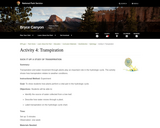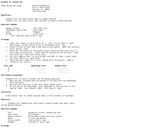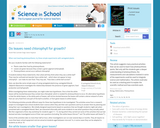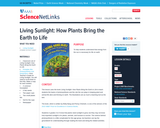
This parent guide supports parents in helping their child at home with the 6th grade Science content.
- Subject:
- Science
- Material Type:
- Reference Material
- Vocabulary
- Author:
- Kelly Rawlston
- Letoria Lewis
- Date Added:
- 10/11/2022

This parent guide supports parents in helping their child at home with the 6th grade Science content.

This resource accompanies our Rethink 6th Grade Science course. It includes ideas for use, ways to support exceptional children, ways to extend learning, digital resources and tools, tips for supporting English Language Learners and students with visual and hearing impairments. There are also ideas for offline learning.

In this lesson, students investigate how plants perform a vital part in the hydrologic cycle.

Students will conduct simple investigations to observe plant responses to light.

Students will investigate photosynthesis.

Students will learn the basic principle of photosynthesis and how light intensity diminishes as a function of distance from the light source.

This resource is an article discussing the processes of photysynthesis and respiration.

In this lesson, students identify atoms as the smallest building block of matter and explain that atoms, in different combinations, form different materials. Students will also differentiate between photosynthesis and respiration.

Students investigate the relationship between the presence of green pigment, food production, and leaf growth.

In this lesson, students explain the processes by which plants capture, store, and use energy for growth and development.

This content resource builds students' knowledge and conceptual understanding about plants through interactive activities, printable worksheets, and hands-on explorations. There are six investigation cases for students to complete; each case examines a different aspect of plant life, including plant structures, life cycles and reproduction, proper environmental conditions for growth, and ecological importance. Supplemental background information and a teacher's guide with suggestions for using the materials in the classroom are also provided. A Spanish version of the web site is available.

In this activity, students explore how plants turn sunlight into food through a process called photsynthesis.

The three interactive resources in this collection clearly show students what occurs during the process of photosynthesis, including an exploration at the molecular level in the "Atomic Shuffle" interactive.

In this lesson, students will interpret data on the evolution of plants and the change in the atmosphere, and construct a drawn model of photosynthesis.

In this experiment, the rate of photosynthesis is measured by counting the number of bubbles rising from the cut end of a piece of Elodea or Cabomba.

In this inquiry lab, students design and conduct simple experiments using elodea and Bromthymol blue to determine whether plants consume or release carbon dioxide in the process of photosynthesis. Students will record their data which will be used to conclude whether carbon dioxide was consumed or released by the elodea. Through class discussion of student data, students will learn that carbon dioxide was consumed during photosynthesis. At the end of the class discussion students will be asked to answer 5 follow-up questions

Looking for lichens is an activity that can be done almost anywhere. Students get to search for them in the playgrounds and schoolyards, and they can be used as an indicator of air quality.

In this activity, students will conduct a series of hands-on experiments that will demonstrate how the working of these veins, known as capillary action, enables water to travel throughout the length of a plant. Students will learn how the forces of water cohesion and adhesion contribute to the process of capillary action.

Students learn how energy from the sun makes life on earth possible. Note: This lesson is reliant on the book Living Sunlight: How Plants Bring the Earth to Life by Molly Bang and Penny Chisholm.

In this STEM unit, students participate in an activity to grow plants in an environment very similar to the moon, which is designed in a unique partnership between NASA scientists and engineers and education professionals. The lesson incorporates leading-edge insight and practical experiences for students on how NASA works with plants. Students will describe the need for life science research on the International Space Station and the moon. They will also identify various plant species that are suitable for lunar plant growth and their requirements. In the culminating activities, students design and construct a working prototype of a plant growth chamber.
.